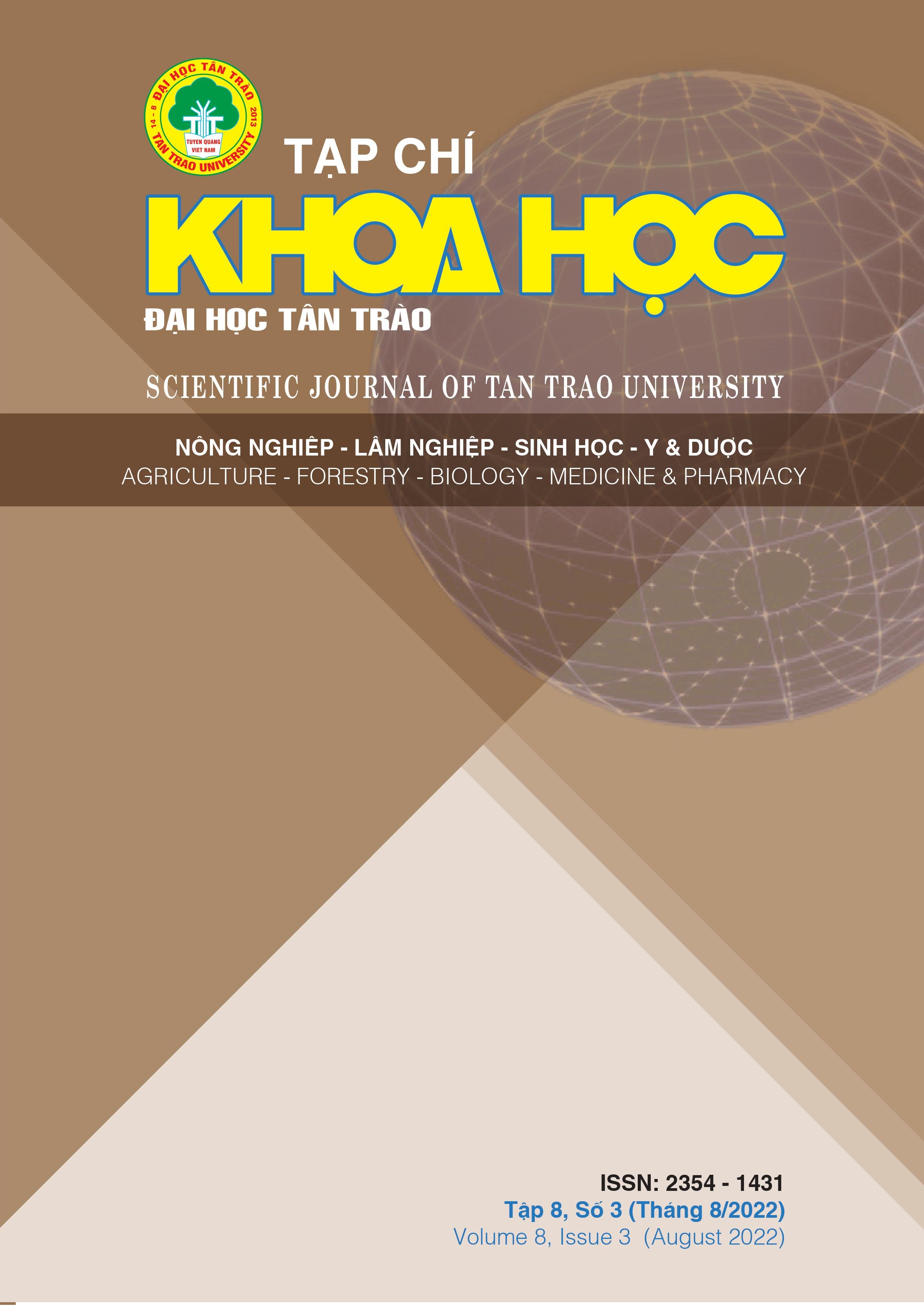RESEARCH OF EXTRACTION PROCESS AND CHEMICAL COMPOSITION OF Pluchea indica (L.) Less. ESSENTIAL OIL IN THAI NGUYEN
DOI:
https://doi.org/10.51453/2354-1431/2022/806Keywords:
Pluchea indica (L.) Less, essential oil, extraction, box-behnkenAbstract
According to modern medicine, many studies prove that chrysanthemum has antioxidant, anti-inflammatory, anti-ulcer, antipyretic, hypoglycemic, diuretic and anti-bacterial activities and many useful uses and effects. The purpose of the study is to investigate single factors affecting the extraction process of essential oils. On the basis of surveying factors affecting extraction conditions by experimental planning method Box- Behnken has found the optimal temperature condition is: 100.41oC; The optimal solvent/material ratio is: 1.65 (mL/g); The optimal time parameter is: 58.65 minutes. It has been identified that essential oils have 25 substances with high biological value, essential oils exhibit antibacterial and antioxidant activities.
Downloads
References
[1]. Nguyễn Thị Chung (1999), Nghiên cứu thành phần hóa học của tinh dầu cúc tần Pluchea indica (L.) less ở Nghệ An, Luận văn thạc sỹ khoa hóa học Đại học Vinh 1999.
[2]. Võ Văn Chí (1999), Từ điển cây thuốc Việt Nam.Nxb y học 1999.
[3]. Đinh Thị Kim Hoa , Nguyễn Thị Tình , Tạ Thị Lượng, Nguyễn Văn Duy, Nguyễn Thị Trà My, Lê Thị Hồng Ngọc, Nông Thị Hồng Ngọc, Vi Đại Lâm, Lưu Hồng Sơn (2021), “Nghiên cứu quy trình tách chiết carotenoid tổng số từ lá cúc tần (pluchea indica less.) thu hái tại thái nguyên”.
[4]. PGS.TS.Phạm Đình Hùng, và cộng sự (2005), “Nghiên cứu tách chiết, xác định cấu trúc các hợp chất có hoạt tính sinh học cao từ các cây thuộc họ cúc, cà phê, ô rô, bứa và một số họ khác mọc phổ biến ở miền nam Việt Nam”.
[5]. Lê Mai Hương (2020), Nghiên cứu các yếu tố ảnh hưởng đến khả năng tách chiết tinh dầu từ lá trầu không và đánh giá hoạt tính kháng khuẩn của tinh dầu, Luận văn tốt nghiệp chuyên ngành công nghệ thực phẩm Đại học Nông Lâm Thái Nguyên.
[6]. Phạm Thanh Kỳ (1998), Bài giảng dược liệu, Đại học dược Hà Nội.
[7]. Đỗ Tất Lợi (1997), Cây thuốc Bắc Nam, Nxb Y học.
[8]. Đỗ Tất Lợi (2004), “Những cây thuốc và vị thuốc Việt Nam”, tr. 668- 669. Nxb y học.
[9]. Lã Đình Mới (2001), Tài nguyên thực vật có tinh dầu ở Việt Nam, Nxb Nông nghiệp Hà Nội.
[10]. Nguyễn Duy Phước (2003), Nghiên cứu thành phần hóa học của tinh dầu cây cúc tần (Pluchea indica(L.) Less) ở Hà Tĩnh, Luận văn tốt nghiệp chuyên ngành hóa hữu cơ Đại học Vinh.
[11]. Cho et al. (2012), Crude aqueous extracts of Pluchea indica (L.) Less. inhibit proliferation and migration of cancer cells through induction of p53-dependent cell death. BMC complementary and alternative medicine, 12, 265.
[12]. Lê Văn Hạc, Nguyễn Thị Chung, Nguyễn Xuân Dũng, Hồ Quang Trung, and Piet.A.Leclerq constituents of leaf and root essentianal oil of Pluchea indica(L.) Less from Viet Nam, J.of essential oil- Brearing Plant.2000, Vol. 3, No.1, pp 21-29.
Downloads
Published
How to Cite
Issue
Section
License

This work is licensed under a Creative Commons Attribution-ShareAlike 4.0 International License.
All articles published in SJTTU are licensed under a Creative Commons Attribution-ShareAlike 4.0 International (CC BY-SA) license. This means anyone is free to copy, transform, or redistribute articles for any lawful purpose in any medium, provided they give appropriate attribution to the original author(s) and SJTTU, link to the license, indicate if changes were made, and redistribute any derivative work under the same license.
Copyright on articles is retained by the respective author(s), without restrictions. A non-exclusive license is granted to SJTTU to publish the article and identify itself as its original publisher, along with the commercial right to include the article in a hardcopy issue for sale to libraries and individuals.
Although the conditions of the CC BY-SA license don't apply to authors (as the copyright holder of your article, you have no restrictions on your rights), by submitting to SJTTU, authors recognize the rights of readers, and must grant any third party the right to use their article to the extent provided by the license.


